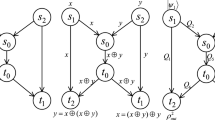Abstract
Quantum decoherence leads to environment-induced superselection of preferred states. Some information in the measurement apparatus is lost during communication. Even if the measurement apparatus is not entangled with the system of interest, the loss of information would occur. In this paper, we propose a feasible quantum network coding scheme reducing decoherence effect to transmit the mutual information between source node and target node. With the help of entanglement distribution by separable states, the quantum network coding scheme initially achieves quantum entanglement distribution of two crossing source-target pairs in a butterfly network. Furthermore, by means of transmission of correlations, the maximal mutual information resulting from local operations and classical communication will be transmitted to a distant receiver. Compared with the representative quantum network coding schemes, the proposed scheme transmits correlations rather than quantum state over the butterfly network. The upper bound to the concentrated information is also quantified. Analysis indicates that the proposed scheme can effectively defend against active attacks with fewer resource consumption and good region rate.






Similar content being viewed by others
Explore related subjects
Discover the latest articles, news and stories from top researchers in related subjects.References
Shang, T., Liu, J.W.: Secure Quantum Network Coding Theory. Springer, Berlin (2020)
Hayashi, M., Iwamam, K.: Quantum network coding. Theoretical Aspects of Computer Science. Lecture Notes in Computer Science. vol. 4393, pp. 610–621 (2007)
Hayashi, M.: Prior entanglement between senders enables perfect quantum network coding with modification. Phys. Rev. A vol 76(4), 538 (2007)
Satoh, T., Gall, F.L., Imai, H.: Quantum network coding for quantum repeaters. Phys. Rev. A 86(3), 1–8 (2012)
Shang, T., Li, K., Liu, J.W.: Continuous-variable quantum network coding for coherent states. Quantum Inf. Process. vol 20(4), 291 (2017)
Bennett, C.H., Divincenzo, D.P.: Quantum information and computation. Nature 48(10), 24–30 (1995)
Ollivier, H., Zurek, W.H.: Quantum discord: a measure of the quantumness of correlations. Phys. Rev. Lett. 88(1), 017901 (2001)
Zurek, W.H.: Quantum discord and Maxwell’s demons. Physics 67(1), 012320 (2003)
Streltsov, A., Kampermann, H., Bruss, D.: Linking quantum discord to entanglement in a measurement. Phys. Rev. Lett. vol 106(16), 160401.1-160401.4 (2011)
Madhok, V., Datta, A.: Interpreting quantum discord through quantum state merging. Phys. Rev. A 83, 032323 (2011)
Zurek, W.H.: Quantum Darwinism, classical reality, and the randomness of quantum jumps. Phys. Today 67(10), 44–50 (2014)
Zurek, W.H.: Decoherence, einselection and the quantum origins of the classical. Rev. Mod. Phys. 75(3), 715–775 (2001)
Modi, K., Brodutch, A.: The classical-quantum boundary for correlations: discord and related measures. Rev. Mod. Phys. 84, 1655 (2012)
Streltsov, A., Zurek, W.H.: Quantum discord cannot be shared. Phys. Rev. Lett. vol 111(4), 040401.1-040401.5 (2013)
Bohr, N.: Essays on atomic physics and human knowledge. Philos. Phenomenol. Res. vol 21(8), 276 (1960)
Chitambar, E., Duan, R., Hsieh, M.H.: When do local operations and classical communication suffice for two-qubit state discrimination? IEEE Trans. Inf. Theory 60(3), 1549–1561 (2014)
Zurek, W.H.: Quantum darwinism. Nat. Phys. 5, 181–188 (2009)
Horodecki, R., Korbicz, J.K., Horodecki, P.: Quantum origins of objectivity. Phys. Rev. A 91(3), 032122 (2015)
Ollivier, H., Poulin, D., Zurek, W.H.: Objective properties from subjective quantum states: environment as a witness. Phys. Rev. Lett. vol 93(22), 220401.1-220401.4 (2004)
Henderson, L., Vedral, V.: Classical, quantum and total correlations. J. Phys. A Gen. Phys. 34(35), 6899–6905 (2001)
Ollivier, H., Zurek, W.H.: Quantum discord: a measure of the quantumness of correlations. Phys. Rev. Lett. 88(1), 017901 (2002)
Streltsov, A., Lee, S., Adesso, G.: Concentrating tripartite quantum information. Phys. Rev. Lett 115(3), 030505 (2015)
Devetak, I., Winter, A.: Distillation of secret key and entanglement from quantum states. Proc. R. Soc. A: Math. Phys. Eng. Sci. 461, 207–235 (2003)
Leung, D., Oppenheim, J., Winter, A.: Quantum network communication—the butterfly and beyond. IEEE Trans. Inf. Theory 56, 3478–3490 (2010)
Bru, D., Divincenzo, D.P., Ekert, A., et al.: Optimal universal and state-dependent quantum cloning. Phys. Rev. A 57(4), 2368–2378 (1997)
Ma, S.Y., Chen, X.B., Luo, M.X., et al.: Probabilistic quantum network coding of M-qudit states over the butterfly network. Opt. Commun. 283(3), 497–501 (2010)
Zhang, S., Li, J., Dong, H.J., et al.: Quantum network coding on networks with arbitrarily distributed hidden channels. Commun. Theor. Phys. 60(10), 415–420 (2013)
Wang, F., Luo, M.X., Xu, G., et al.: Photonic quantum network transmission assisted by the weak cross-kerr nonlinearity. Sci. China Phys. Mech. Astron. 61(6), 8–23 (2018)
Bennett, C.H., Brassard, G., Popescu, S., et al.: Purification of Noisy Entanglement and Faithful Teleportation via Noisy Channels. Phys. Rev. Lett. 76(5), 722–725 (1996)
Duan, L.M., Kimble, H.J.: Scalable photonic quantum computation through cavity-assisted interactions. Phys. Rev. Lett. 92(12), 127902 (2004)
Borregaard, J., Komar, P., Kessler, E.M., et al.: Long-distance entanglement distribution using individual atoms in optical cavities. Phys. Rev. A 92(1), 012307 (2015)
Zhang, C.W., Li, C.F., Wang, Z.Y., Guo, G.C.: Probabilistic quantum cloning via Greenberger–Horne–Zeilinger states. Phys. Rev. A 62(4), 190–191 (2000)
Galve, F., Zambrini, R., Maniscalco, S.: Non-Markovianity hinders quantum Darwinism. Sci. Rep. 6, 19607 (2016)
Reiserer, A., Rempe, G.: Cavity-based quantum networks with single atoms and optical photons. Rev. Mod. Phys. vol 87(4), 1379 (2015)
Acknowledgements
This project was supported by the National Natural Science Foundation of China (No. 61971021 and 61571024), the Aeronautical Science Foundation of China (No. 2018ZC51016) and the National Key Research and Development Program of China (No. 2016YFC1000307).
Author information
Authors and Affiliations
Corresponding author
Additional information
Publisher's Note
Springer Nature remains neutral with regard to jurisdictional claims in published maps and institutional affiliations.
Rights and permissions
About this article
Cite this article
Shang, T., Zhang, Y., Liu, R. et al. Quantum network coding reducing decoherence effect. Quantum Inf Process 20, 267 (2021). https://doi.org/10.1007/s11128-021-03200-2
Received:
Accepted:
Published:
DOI: https://doi.org/10.1007/s11128-021-03200-2




